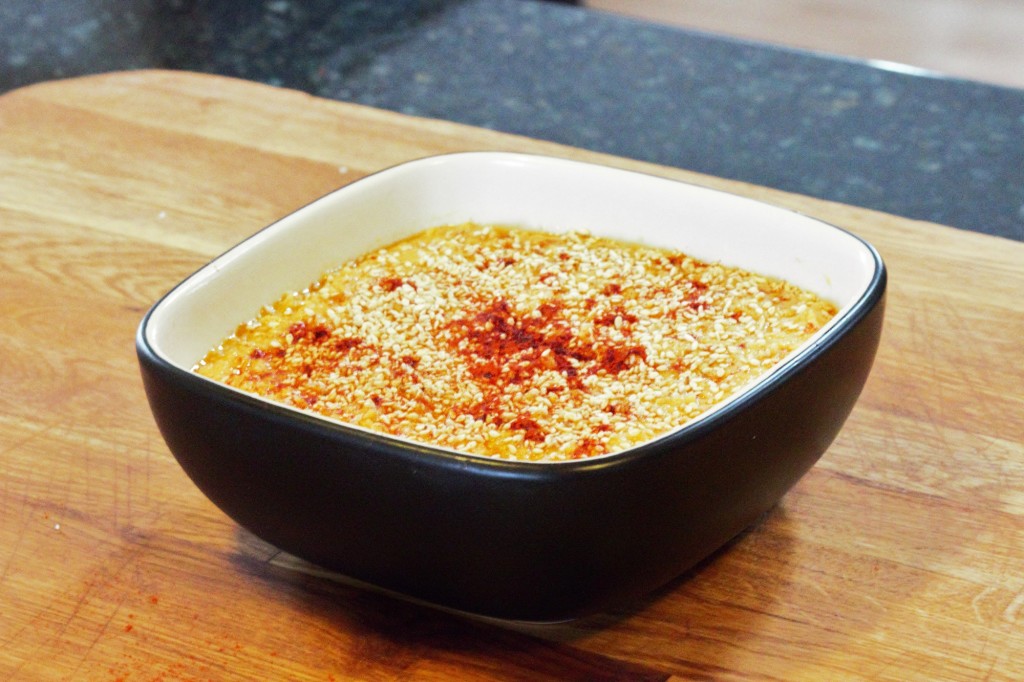
Hummus is one of the great standards as a snack or side dish. Originating in the Middle East, it is now enjoyed around the world and is very simple to make from scratch yourself. Essentially a dip made from garbanzo beans (known as chickpeas in some circles), hummus has many other uses and can be made with as little as six ingredients. Try it as a sauce to compliment a steak or lamb– or any other red meat for that matter–, or as a spread in sandwiches and wraps in place of butter or mayonaise. It can be made in its basic form as mentioned, but can easily be enhanced with various herbs and spices; don’t be afraid to get creative! Here we’ll show you a basic do-it-yourself hummus recipe; including how to make your own tahini from raw organic sesame seeds.
Ingredients:
3 cups garbanzo beans (becoming just over 6 cups once soaked and cooked)
1/4 cup hulled sesame seeds
3.5 tbsp lemon juice
2 cloves chopped or mince garlic (or more if you prefer)
6 tbsp olive oil (hummus), 2 tbsp olive oil (tahini)
1 tsp salt
1-2 tsp paprika (smoked or regular)
*If using store bought tahini- use approx. 6 tsp, or to taste.
Directions:
At Grainworks, we are firm believers that it is best to use fresh ingredients with as little processing as possible. This recipes features our organic garbanzo beans, which are packaged dry (in their best state for storage). Starting with dry beans, it is important to soak them in water for 24 hours before making your hummus. The beans will roughly double in size, so you will want to cover them with approx. 2 inches of water. Drain the water once the beans have soaked and discard. Aside from helping get the beans to the right tenderness, soaking also removes some of the complex sugars that surround the outside of the bean making them harder to digest.. you know that old saying, “beans, beans, the magical fruit. The more you eat, the more you… . Well, soaking the beans helps to lessen that effect, and discarding the water the beans were soaked in ensures these indigestibles don’t make their way back into our recipe. Though preffered, if 24 hours is not available to soak- bringing the beans to a boil and simmering for an hour on low heat can have a similar effect. *They will expand by roughly double when soaked (by either method) so be sure to have enough water to accommodate.*
Now that our beans are soaked, we need to cook them to the desired tenderness. Many garbanzo bean recipes can be made with well soaked beans, but the smooth consistency of hummus is best achieved with very tender beans. Boiling them in water for 60-90 minutes will get them there. Once fully cooked, strain and let cool. You may want to save some of the water from boiling to help achieve desired consistency later on if you wish to limit the amount of oil in the recipe.
Tahini:
Home made tahini tastes better, and is more nutritious than store-bought, so while the beans are cooking, it is a perfect opportunity to make your own tahini. Tahini is essentially a sesame paste, and simply involves mashing sesame seeds with olive oil and fortunately, Grainworks also carries organic hulled sesame seeds.
Roasting the sesame seeds first enhances their flavor and aroma. In a cast iron skillet or frying pan, roast the sesame seeds for 5 min until golden brown. *If they turn dark brown they are getting overcooked.* Make sure to move them around in the skillet to help spread the heat and roast the seeds more evenly. Let cool.
Using a food processor or other method (mortar and pestle is great for this small amount), mash the roasted seeds together with the 2 tbsp of olive oil until you achieve a paste-like consistency. Try roasting some extra sesame seeds to add to the top of the hummus as a garnish or for an extra nutty flavor. Pictured below is our tahini from scratch with the correct coloration for roasted sesame seeds.
Now back to our hummus. Once cooked, the beans and other ingredients essentially just need to be made into the smooth dippable consistency of hummus. A food processor is the most convenient way to achieve this, but hand methods such as a potato masher or large wooden spoon in a bowl (larger version of mortar and pestle) can be used. If the beans are the right tenderness they come apart quite easily. As you begin by mashing the beans, add in the olive oil, lemon juice, tahini, salt, paprika, and garlic. The above amounts are estimations and can be adjusted to taste. It is personal preference to whether you mix in the paprika to the entire hummus or use it (or your other favorite spice) to sprinkle over the top. *If you have a few flavors in mind, you can separate the hummus into several different portions and this lets you customize each different one.
There you have it! A simple, yet classic basic hummus. In this recipe we used smoked paprika throughout the entirety of our hummus and opted to sprinkle the remainder of our roasted sesame seeds to add a slight nutty flavour over the top at the end. Other great ways to personalize your hummus could include adding: sauteed onions and mushrooms, roasted red peppers, curry spices, dill and lemon… the possibilities are endless!
